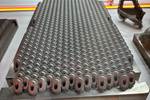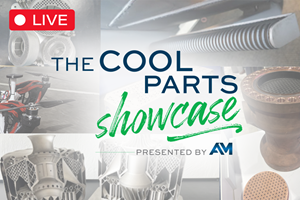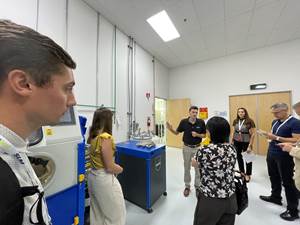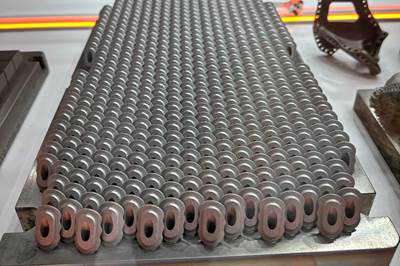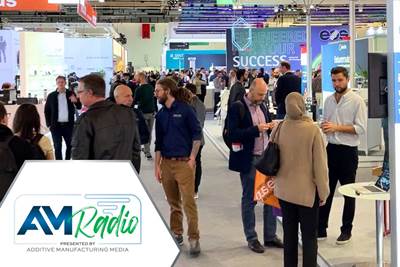10 Video Reports From Formnext 2023
Our Formnext video playlist: Stephanie Hendrixson and Peter Zelinski report on various technologies seen at Formnext 2023 in brief videos they filmed at the show.
Share
Read Next
Additive Manufacturing Media’s Stephanie Hendrixson and I both attended this year’s Formnext expo in Frankfurt, Germany — the largest annual event for additive manufacturing technology. There was a lot to see and learn about, including various important AM technology advances, but we found time along the way to film and post various brief video reports from the show. To see some of what impressed us at Formnext 2023 and to get a feel for the show, here is the playlist of videos we filmed at the event.
Directed Energy Deposition at Large and Small Laser Sizes
In directed energy deposition (DED), a rapid rate of metal deposition can build a large part quickly and a fine rate can offer control for precise features, but is it possible to have both? A solution from Insstek involves adjusting optics mid-build to shift between different laser spot sizes, and therefore different rates of melting.
3D Printing With Liquid Aluminum
Valcun’s Minerva machine uses Molten Metal Deposition to create parts using standard aluminum welding wire. The material is melted in a crucible within the 3D printer, then deposited by a ceramic nozzle onto the build platform. The resulting parts can be anodized, welded and treated like any other aluminum components.
Using Density to Confirm Solidness of 3D Printed Parts
One of the QA requirements for many 3D printing applications is to confirm the part is fully solid. Technology from Dimensionics Density offers an easy way to do this: Measure the part’s density to indicate a lack of internal voids. The company’s new system quickly weighs a part in two different fluids, with the difference in weight allowing the part’s density to be precisely known.
Reinforcing AM Parts With Continuous Fiber Injection
Reinforce3D’s Continuous Fiber Injection Process strengthens 3D printed parts after printing. Carbon fiber is fed through channels in the part, along with composites-grade resin that acts as not only a lubricant, but also an adhesive that might join assembled components together.
Syncing Laser and Recoater for Faster LPBF
Renishaw’s “Tempus” is an improvement to its laser powder bed fusion (LPBF) system achieved entirely through a control algorithm. Instead of laser melting and recoating of the powder bed being separate steps, the Tempus system integrates them, so melting happens as the recoater arm moves. The result is potentially significant reduction in build time.
3D Printing Elastomers Onto Textiles
3D printing directly onto fabric offers the chance to provide structure or shape to a garment, add visual interest, and reduce process steps, as well as add new functionality to textiles. This dress created by Chromatic 3D in collaboration with Dutch designer Anouk Wipprecht features 75 LEDs enclosed in domes that were 3D printed directly onto the fabric.
Mobile Robot for Print Farm Automation
In a “print farm” arrangement of many small 3D printers, an autonomous mobile collaborative robot is potentially a fitting automation choice. By traveling to each 3D printer finishing a job, the mobile robot can unload parts and load new build trays for potentially 100 such machines. Branch Robotics and Print&Go demonstrated this solution.
Ceramic Parts 3D Printed Using Nanoparticles
Ricoh’s binder jetting process 3D prints relative large green forms of ceramic components using powder particles that are actually clusters of ceramic nanoparticles held together with resin. The binder also contains ceramic nanoparticles, and when it hits the powder bed, it permeates the powder to distribute ceramic particles evenly.
Hybrid Machine With Liquid Metal Plus Laser Wire DED
In AM, “hybrid” generally refers to a machine with two processes: machining plus 3D printing. A hybrid from AddiTec offers three processes, because there are two modes of depositing metal. With two different heads and two different material feeds, the machine can 3D print in metal through wire arc additive manufacturing using a laser, and also apply a newer process, liquid metal jetting.
8 Cool Parts From Formnext 2023
And there were cool parts at the show as well! Here is an episode of The Cool Parts Show all about interesting 3D parts we found at Formnext 2023.
Related Content
Meet The Cool Parts Showcase Winners
The Cool Parts Showcase winners for 2023 were announced at Formnext Forum Austin. Watch the award presentation here.
Read More7 Things We Saw at Formnext 2024 — Video Playlist
There were countless processes, applications and announcements at Formnext 2024. Here are seven standouts Peter Zelinski and Stephanie Hendrixson caught on film.
Read MoreThe AM Ecosystem, User Journeys and More from Formnext Forum Austin: AM Radio #43
Sessions and conversations at the first U.S. Formnext event highlighted the complete additive manufacturing ecosystem, sustainability, the importance of customer education, AM user journeys and much more.
Read MoreLithoz CeraFab System S320 LCM Printer Designed for Efficient, High-Capacity Industrial Serial Production
Formnext 2024: The system offers a build speed of up to 150 layers per hour and layer thickness of 20–200 µm.
Read MoreRead Next
8 Cool Parts From Formnext 2023: The Cool Parts Show #65
New additive manufacturing technologies on display at Formnext were in many cases producing notable end-use components. Here are some of the coolest parts we found at this year’s show.
Read MoreCopper, New Metal Printing Processes, Upgrades Based on Software and More from Formnext 2023: AM Radio #46
Formnext 2023 showed that additive manufacturing may be maturing, but it is certainly not stagnant. In this episode, we dive into observations around technology enhancements, new processes and materials, robots, sustainability and more trends from the show.
Read MoreBike Manufacturer Uses Additive Manufacturing to Create Lighter, More Complex, Customized Parts
Titanium bike frame manufacturer Hanglun Technology mixes precision casting with 3D printing to create bikes that offer increased speed and reduced turbulence during long-distance rides, offering a smoother, faster and more efficient cycling experience.
Read More

